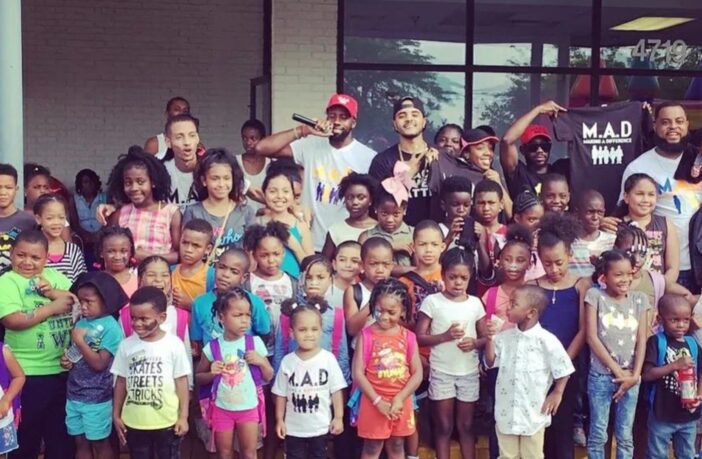By D. Kevin McNeir
Special to the AFRO
June is National Gun Violence Awareness Month, a time when many Americans give greater focus to the devastating impact of gun violence and consider possible solutions to a problem that, in recent years, has only gotten worse.
While any instance of gun violence is troubling, perhaps most alarming are the daily televised news reports or stories in print and social media which center on youth-involved gun violence – some serving as the triggerman while others become the latest victims.
Leaders of the Prince George’s County-based nonprofit Making A Difference (M.A.D™) acknowledge and celebrate the positive decisions and achievements of youth throughout the Greater Washington Area each and every day – no matter how small they may seem to be. (Photo courtesy Chris Thomas)
The American Academy of Family Physicians now recognizes violence as a major public health concern, as do the Centers for Disease Control and Prevention (CDC) who in February 2024 released an in-depth analysis, “Preventing Youth Violence.” The report addresses the myriad of ways that gun violence involving youth often results in lifelong physical and psychological damage, and provides strategies to reduce the surge in youth injuries and deaths.
In the overview of the report, the CDC posits that “youth violence is a serious problem that can have lasting harmful effects on victims and their families, friends and communities.” The CDC report continues, “to prevent youth violence, we must understand and address risk and protective factors at the individual, relational, community and societal levels.”
Recommended strategies include promoting family environments that support healthy development, providing quality education early in life, strengthening youth’s skills, connecting youth to caring adults and activities, creating protective community environments and intervening to lessen harms and prevent future risk.
Blacks in Suitland, Md., take their message to the streets to save youth
Prince Hamn, a resident of Suitland, Md., said the increase of gun-related murders in his community, among youth in particular, became so disturbing that he decided to do something about it. He dealt with his anger and frustration positively, founding the nonprofit organization M.A.D™ (“Making A Difference”), after losing several close friends to murder and prison.
In August 2017, M.A.D™ hosted its first Backpack Drive, now an annual event, and distributed more than 125 fully loaded backpacks to children in need. Since then, Hamn, who serves as the organization’s CEO, has taken his message of hope and the importance of thinking and acting more positively to youth wherever he and his staff can find them – including in the streets.
“The media can make even an innocent man look guilty but those of us here in Suitland, a Prince George’s County suburb just a mile away from D.C., know there are folks throughout the DMV who are being proactive in efforts to save our children,” Hamn said. “And there are young people out there who are crying out for help and want to be saved. Unfortunately, the only thing you hear on TV or read in the news are the bad things going on.”
Hamn’s organization works with youth in both Maryland and the District, including a recent go-kart outing for a group of students from Jefferson Middle School in Southwest D.C. Each of the students were also presented with awards for completing a year-long program that includes conflict resolution as an integral part of its training modules.
“We often chastise our children for doing wrong. In fact, far too many parents only pay attention to their children when they get into trouble or do something that’s negative,” he said. “We believe that what children need is more encouragement for the positive things they do.
“Conflict resolution is just one aspect of our strategy. We instill love, which we think equates to time, and we put as much time as possible into youth – our future – so that they begin to love themselves.”
Chris Thomas, also a resident of Suitland, works beside Hamn and is chief of staff for the D.C.-based 100 Fathers, Inc. He said most of the youth with whom he works don’t need someone else to preach to them as much as they need someone who’s simply willing to listen.
“Kids need positive affirmation and when they do positive things, we reward them accordingly,” he said. “A lot of the children we mentor are homeless. In D.C., alone, there are more than 1,000 homeless youth. Many others have been sexually abused or assaulted. They tell us what’s going on, sometimes coming directly to us but other times communicating their pain and frustrations through social media.
“For some of them, even having good grades isn’t something they, or anyone else, celebrate. But when you don’t have clean clothes, don’t have a safe place to live or don’t know when you’re going to eat again, getting good grades is the least of your concerns.”
Black male children, teens disproportionately account for gun violence victims
In 2020, there were more than 11,000 emergency room visits for gunshot injuries among children and teens under the age of 18 – far higher than in other recent years. However, because the CDC’s estimate is only based on a sample of U.S. hospitals, an exact number could not be ascertained.
Further, between 2019 and 2021, the number of children and teens killed by gunfire in the U.S. rose by 50 percent, which coincides with a broader recent increase in firearm deaths among Americans overall.
For Black families, recent statistics do not bode well for the future as some groups of Black children and teens are far more likely than others to die by gunfire. Boys, for example, accounted for 83 percent of all gun deaths among children and teens in 2021, with homicide representing the leading type of gun death in 2021 for youth under 5, between ages 6 to 11 and those ages 12 to 17.
Racial and ethnic differences in gun deaths among youth illustrate the need to provide greater services for children of color. In 2021, 46 percent of all gun deaths among children and teens involved Black victims, even though only 14 percent of the U.S. under-18 population that year was Black. Much smaller shares of gun deaths among children and teens in 2021 involved White (32 percent), Hispanic (17 percent) and Asian (1 percent) victims.
Both Hamn and Thomas agreed that young adults would have a greater chance at refusing to succumb to peer pressure or engaging in illegal activities like shoplifting, carjacking or stealing cars, if they had more positive outlets and greater opportunities for employment.
“We need to open the doors of more churches, increase the number of recreation centers and extend their hours and give kids jobs so they can eat and take better care of themselves,” Thomas said.
Hamn said it’s also important to provide counseling for youth.
“Last year we held a three-day summit and taught the kids how to meditate and how to handle anxiety and panic attacks,” he said. “The environments in which they live can be dangerous and deadly. We need them to know that there are more ways to respond to the stress besides acting out violently.”



